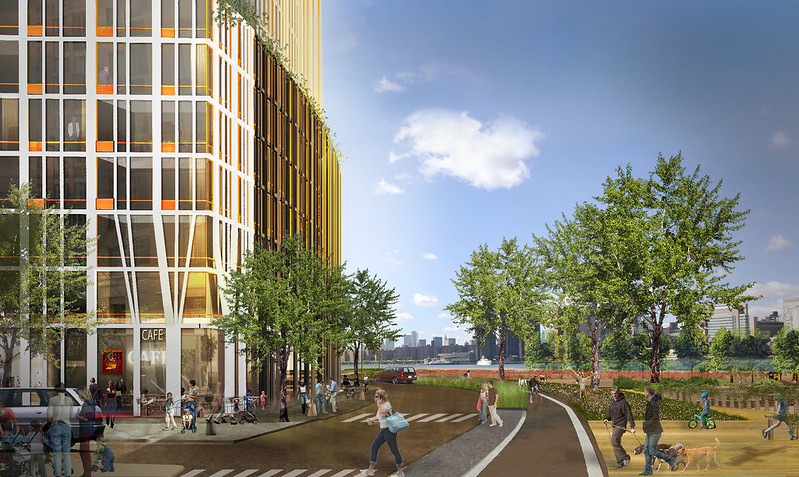
Rendering (photo: mayor's office)
The City Council held a hearing this week on a bill to implement comprehensive long-term planning in New York City. With the right amendments, we think this legislation has the potential to foster a more equitable and rational planning process to guide land-use changes in New York City — one that will balance local and citywide needs.
But comprehensive planning is about much more than land use. Done right, comprehensive planning touches on decisions in nearly all aspects of city life: education, transportation, public health and safety, sustainability, you name it.
One way to think about comprehensive planning is that it will finally provide a formal structure for city agencies to coordinate what they are doing and to stop the ill-informed, piecemeal decision-making that has led to unanticipated (but hardly unforeseeable) consequences.
Our organizations have seen this tragedy play out again and again. In 2003, for example, the City rezoned Fourth Avenue in Brooklyn with the inscrutable goal of creating a “canyon of housing.” The City pursued this narrow goal so myopically that it refused to seize obvious opportunities for preserving and creating affordable apartments--essentially extending and exacerbating the exclusive character of nearby Park Slope.
Over a decade-and-a-half later the community is still cleaning up the mess. The resulting influx of new, affluent residents immediately caused nearby schools to become not only severely overcrowded, but far more segregated as low-income children of color could no longer find seats there. One school had to reduce its attendance zone by half, one school had to be demolished and rebuilt with triple the former number of seats, and a third had to open anew. Although situated atop three subway lines, the tall new buildings included large underground garages belching out vehicles onto sidewalks; the pedestrian experience became intolerable. Lacking meaningful design guidelines, the resulting streetscape of blank walls and ventilation grates is some of the worst in the city.
Every one of these problems could have been anticipated and addressed through a formal process that provided meaningful opportunities for the community to engage in planning, required different city agencies to coordinate their long-term plans, and, most importantly, adhered to clear and immovable guiding principles such as racial justice, reduction of segregation in schools and neighborhoods, net creation of affordable housing, and prioritization of public transit and pedestrian safety and accessibility. This is what comprehensive planning promises.
Imagine if diverse government agencies and community members (given the proper resources) had been planning and thinking in advance — long before this rezoning process even started…
About how upgrades to public transportation and bicycle infrastructure could obviate the need for underground garages for luxury housing towers with comparatively excellent subway access?
About a plan to coordinate the creation of new market-rate and affordable housing with innovative student-assignment policies that would lead to more affordable housing in well-resourced areas of the city, racial and economic integration of the neighborhood and its schools, and more efficient use of existing school buildings?
About how to improve pedestrian safety and reduce traffic violence so parents can feel comfortable sending their children to the broad range of schools and parks within walking distance?
About the role of an individual action like the Fourth Avenue rezoning in advancing racial justice, equity, and integration across the city as a whole? And in shifting the benefits and burdens of city life, growth, and change equitably?
Is this a fantasy? Not at all. In fact, comprehensive planning is the norm for most municipalities of any size. New York City’s exceptional size, complexity, and competing needs only increase the necessity of a formal and predictable planning process.
The current legislation requires some amendments to enshrine better public transit, specifically faster buses, and integration as explicit goals; to give local communities a real opportunity to plan proactively without being allowed to override the public good of the city as a whole; and to ensure that the plan will actually guide official decision-making.
This is work worth doing. We can get this right, and the time is now to make it happen. We simply can’t tolerate any more of the status quo.
***
Danny Pearlstein is the Policy and Communications Director at the Riders Alliance. David Tipson is the Executive Director of New York Appleseed. Both organizations are members of the Thriving Communities Coalition. On Twitter @RidersAlliance, @AppleseedNY & @thrivingccnyc.
***
Have an op-ed idea or submission for Gotham Gazette? Email This email address is being protected from spambots. You need JavaScript enabled to view it.




